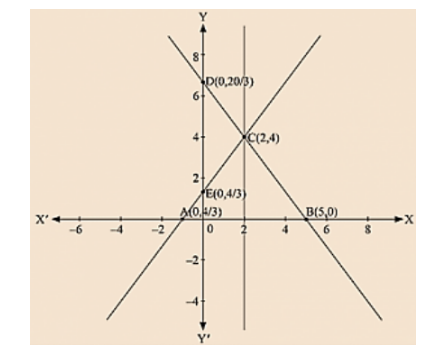Draw the graphs of the linear equations 4x - 3y + 4 = 0 and 4x + 3y - 20 = 0. Find the area bounded by these lines and x-axis.
We are given, 4x - 3y + 4 = 0
We get,
$y=\frac{4 x+4}{3}$
Now, substituting x = 0 in
$y=\frac{4 x+4}{3}$
we get
Substituting x = -1 in
$y=\frac{4 x+4}{3}$
we get y = 0
Thus, we have the following table exhibiting the abscissa and ordinates of points on the line represented by the given equation

Plotting E(0, 4/3) and A (-1, 0) on the graph and by joining the points,
We obtain the graph of equation 4x - 3y + 4 = 0.
We are given, 4x + 3y - 20 = 0
We get,
$y=\frac{20-4 x}{3}$
Now, substituting x = 0 in
$y=\frac{20-4 x}{3}$
we get y = 7
Substituting x = 5 in
$y=\frac{20-4 x}{3}$
we get y = 0
Thus, we have the following table exhibiting the abscissa and ordinates of points on the line represented by the given equation

Plotting D (0, 20/3) and B (5, 0) on the graph and by joining the points, we obtain the graph of equation 4x +3y - 20 = 0.

By the intersection of lines formed by 4x - 3y + 4 = 0 and 4x + 3y - 20 = 0 on the graph,
Triangle ABC is formed on x axis.
Therefore, AB at x axis is the base of triangle ABC having AB = 6 units on x axis.
Draw CF perpendicular from C on x axis. CF parallel to y axis is the height of triangle ABC having CF = 4 units on y axis.
Therefore, Area of triangle ABC, say A is given by A = (Base × Height)/2
A = (AB × CF)/2
A = (6 × 4)/2
K = 12 sq. units
Click here to get exam-ready with eSaral
For making your preparation journey smoother of JEE, NEET and Class 8 to 10, grab our app now.
